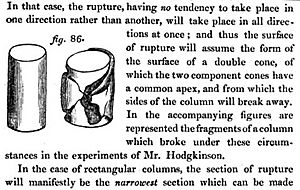Eaton Hodgkinson facts for kids
Quick facts for kids
Eaton Hodgkinson
|
|
|---|---|
| Born | 26 February 1789 |
| Died | 18 June 1861 (aged 72) |
| Nationality | English |
| Occupation | Engineer |
Eaton Hodgkinson (born February 26, 1789 – died June 18, 1861) was an English engineer. He was a very important person who used mathematics to figure out how strong buildings and bridges should be. He helped design structures that could stand strong and safe.
Contents
Early Life and Learning
Eaton Hodgkinson was born in a small village called Anderton, near Northwich, Cheshire, England. His family were farmers. When he was six years old, his father passed away. His mother raised him and his two sisters, and she kept the farm running.
Eaton went to Witton Grammar School in Northwich. His family hoped he would become a priest in the Church of England. But Eaton didn't enjoy studying old languages like Greek and Latin. He was much better at and more interested in mathematics.
His mother noticed this and moved him to a different school in Northwich. There, his love for mathematics grew even more. However, as he got older, he was needed to help out on the family farm. So, he left school to work there.
But farming wasn't what Eaton wanted to do. His mother wanted to help him find something he truly enjoyed. Friends suggested that he might find better opportunities in nearby Manchester. So, in 1811, his family moved to Salford. They started a business there.
Eaton spent all his free time reading about science and mathematics. He soon met other scientists in Manchester. One of them was William Fairbairn, who would later work with him. Eaton also became a student of John Dalton, a famous scientist. They became close friends and remained so until Dalton's death in 1844. Eaton later left the family business to focus on his scientific work.
He was married twice, but he did not have any children.
Amazing Scientific Work
Eaton Hodgkinson did many experiments to test how strong different materials were. He measured the strength of columns made from things like cast iron and marble. This helped engineers understand how much weight these materials could hold.
Hodgkinson worked with Sir William Fairbairn in Manchester. They designed iron beams for bridges. One of their projects was the Water Street bridge for the Liverpool and Manchester Railway in 1828–30.
He came up with a better shape for iron beams. This new shape made the beams much stronger. He published his ideas in 1830. His work greatly influenced how engineers designed structures in the 1800s. He even created a formula to predict when a beam would break under a heavy weight.
Designing the Britannia Bridge
Eaton Hodgkinson was also a consultant for the Britannia Bridge. This was a very new and special bridge design. It was a tubular bridge, meaning it was made of large tubes.
Fairbairn built and tested many models of the bridge. He developed the final design. Both Hodgkinson and Robert Stephenson thought that extra chains would be needed to support the heavy parts of the bridge. So, the towers were built with spaces for these chains.
However, Fairbairn believed the chains wouldn't be necessary. He was right! The chains were never used, but the empty spaces for them are still visible in the towers today.
Later Life and Recognition
In 1841, Eaton Hodgkinson was chosen to be a Fellow of the Royal Society. This is a very high honor for scientists. In 1847, he became a professor at University College London. He taught about the mechanical principles of engineering.
In 1849, the UK Parliament asked him to join a special group. This group investigated how iron was used in railroad structures. He also studied something called metal fatigue. This is when metal gets weaker over time from repeated stress.
Towards the end of his life, Eaton Hodgkinson's health declined. He passed away in Higher Broughton, Salford.
See also
- Box girder
- Cylinder stress



